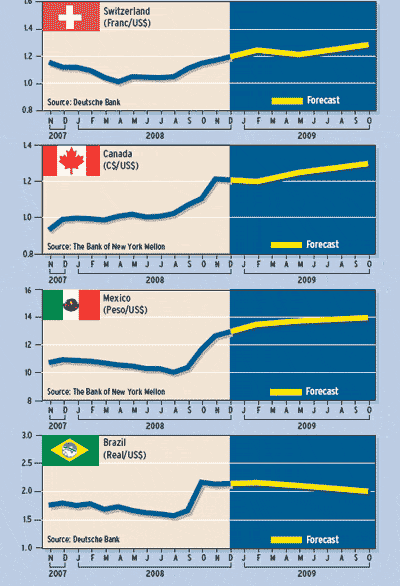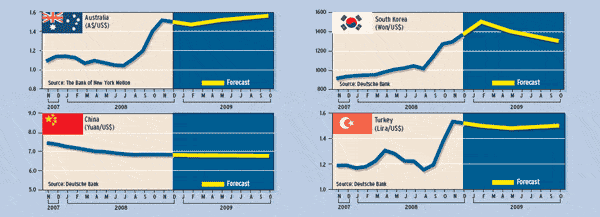FOREIGN EXCHANGE
 The dollar will resume its remarkable comeback as slumping economies around the world trigger rising credit defaults and usher in a new flight to safety, currency analysts say.
The dollar will resume its remarkable comeback as slumping economies around the world trigger rising credit defaults and usher in a new flight to safety, currency analysts say.
“Developments in the credit and equity markets will remain the deciding factors behind currency moves,” says Nick Harrison, foreign exchange dealer in the London office of Custom House, a Victoria, British Columbia, Canada-based provider of global payment services. “The dollar, perhaps ironically, has been a big winner in the worst financial crisis in decades that started in the United States, as investors dumped riskier assets across the board and scaled back leverage,” he says.
The greenback retreated in early November, however, as frozen credit markets began to thaw and equity markets bounced back. Interest rate cuts and unprecedented provisions of liquidity by central banks, the opening of Federal Reserve swap lines with several emerging market countries and a statement by the Group of Seven industrialized countries warning against a further surge in the yen all contributed to a short-term reversal in currency market trends that began in July.
“The question is whether these moves will be enough to  maintain confidence in the face of economic outcomes that will continue to be extremely weak,” says Steven Englander, chief currency strategist in the Americas for Barclays Capital in New York.
maintain confidence in the face of economic outcomes that will continue to be extremely weak,” says Steven Englander, chief currency strategist in the Americas for Barclays Capital in New York.
Although policy moves have so far been unable to avert the slowdown in economic activity, they show very strong commitment to prevent further turmoil, Englander says. He cited reasons to be cautious, however, about whether this marks a big turn in market sentiment.
“Notwithstanding the policy moves, if anything, economic outcomes look increasingly risky globally,” Englander says. Over the past year, a sequence of policy initiatives has been followed by disappointment as economies and markets did not respond, he says. While governments are likely to follow through with further announcements, the vulnerabilities will remain, according to Englander.
“Economic fundamentals have been pushed to the side and may in fact be having a counter-intuitive impact on the dollar,” says Michael Woolfolk, senior currency strategist at The Bank of New York Mellon. “The weaker the US [economic] numbers get, the higher risk aversion gets, and the greater is the demand for dollars amid strong repatriation flows,” he says.
The sharp rally in the dollar since July has been particularly surprising in the context of the global credit crisis, says Binky Chadha, strategist at Deutsche Bank Securities in New York. “Financing for most entities has been tight, if not shrinking outright, while the US external trade deficit represents arguably the largest financing need in the world,” he says.
The decline of the euro and commodity currencies has further to run, as global recession gets fully priced into the market and investor deleveraging prompts further emerging market reserve losses, according to Chadha. The freezing up of primary bond markets has increased the demand for dollar liquidity, thereby providing short-term financing for the US external deficit, he says.
Meanwhile, numerous emerging market currencies have come under pressure. It seems clear that many emerging market corporations took advantage of the six-year decline in the dollar and the accompanying rise in their currencies to fund themselves increasingly in dollars, Chadha says. As foreign investors repatriated capital in an environment of rising global risk aversion, the downward pressure on local currencies was intensified by local corporations scrambling to buy dollars to meet margin calls and hedge their short dollar positions, he says.
“Central bank interventions to smooth currency movements have implied significant losses of still-ample reserves but have so far had limited impact in reversing the depreciation of the local currencies,” Chadha says. The rising pace of reserve accumulation in recent years meant growing demand for euros by central bank reserve managers as they rebalanced their holdings to keep currency proportions steady, he says.
Amid currency market intervention and recent declines in reserves, the process has been thrown into reverse, which creates a need to sell the euro, Chadha adds. The decline in oil prices will significantly reverse demand for euros by oil-exporting country reserve managers and argues for a stronger dollar, he says.
The London interbank offered rate, or Libor, has retreated from its recent lofty levels as credit market conditions have improved somewhat. “One important aspect of the easing of the acute state of affairs is that the urgency of deleveraging has eased, and this has been expressed in the foreign exchange market as a consolidative phase, says Marc Chandler, global head of currency strategy at Brown Brothers Harriman, based in New York.“While we do not think that the deleveraging process is over yet, weakness in the dollar and yen suggests that the panic is easing,” he says.
The Bank of Japan cut its uncollateralized overnight call rate by 20 basis points to 0.3% on October 31 in a split decision. Japan is now clearly in recession, with gross domestic product in the third quarter almost certain to contract after a 0.7% decline in the second quarter, says Michael Taylor, senior economist at Lombard Street Research, based in London.
In recent weeks Japan has felt the effects of the global credit crunch, despite domestic credit conditions being in much better shape than in the US or Western Europe, Taylor says. Moreover, the reversal of carry trades has resulted in a sharp appreciation of the yen, which has put pressure on Japanese exporters.
Currency traders showed limited reaction to the G-7’s emergency statement that the yen’s excessive volatility was threatening the global economy and financial system. Although the statement was not followed up with concerted intervention by central banks, it left the door wide open for the Bank of Japan to enter the market on its own to restrain the yen’s advance. Japan’s finance minister, Shoichi Nakagawa, said the same day that the Japanese government was ready to act if needed to prevent the strong yen from undermining the nation’s economy.
Bank of Japan data showed that the yen’s real effective exchange rate, which measures the value of the yen against the currencies of Japan’s trading partners, rose by 11.2% in October from September, the largest monthly increase on record.

Gordon Platt



